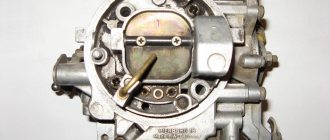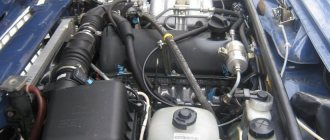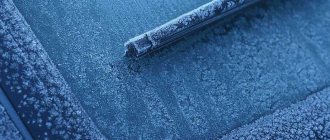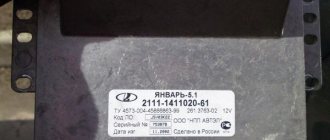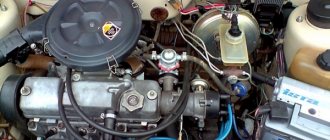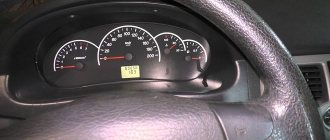Typically, problems with starting a car engine occur in winter, at very low temperatures. However, it often happens that a carburetor engine begins to “be capricious” not in the cold, but on the contrary, when it is warmed up, that is, after several minutes of parking.
Experienced drivers, as a rule, know the features of their car’s engine and how to start it under different conditions, but many motorists experience problems with this, “tormenting” both the starter and the battery and themselves for a long time, trying unsuccessfully to start the car for a long time...
Why is it difficult to start a hot engine?
But, in fact, with a skillful approach, this problem is completely solvable. You need to understand that while the engine is running, a fairly large volume of air passes through the carburetor, which causes the carburetor to cool. The same effect is caused by gasoline passing into the engine through the carburetor. As a result, while the engine is running, the carburetor temperature is always lower than the engine temperature, and, of course, lower than the boiling point of the fuel.
But this situation persists only as long as the engine is running. As soon as the engine stops, the carburetor begins to heat up from the hot engine body, because there is no longer any air flow to cool it. In turn, the gasoline remaining in the carburetor float chamber begins to evaporate rapidly due to the high temperature.
At the same time, fuel vapors fill all accessible cavities, such as the intake manifold, the carburetor itself, the air filter, etc. The fuel level in the float chamber drops below normal; in some cases, gas locks may even form in the fuel supply system.
The duration of the above process depends on the design of the vehicle’s fuel system, the temperature of the engine and ambient air, as well as some other factors, and can last from 5 minutes to half an hour.
If at this moment the engine starts, then the combustion chambers, due to the large amount of gasoline vapor in the intake manifold, receive an over-enriched fuel mixture, that is, a mixture containing an increased percentage of fuel, which is the cause of starting problems.
How to ensure a good start on a hot engine
In order to ensure normal engine starting in such conditions, you need to deplete the mixture to normal, for which, when starting a hot engine, you need to depress the accelerator pedal to half full speed, or even depress the pedal completely - this depends on the specific situation, and on the “character” of the car.
If at the same time you start to “pump” the gas pedal, pressing and releasing it several times, then this can only worsen the situation, because with each sharp press on the pedal, the accelerator pump will send another portion of fuel into the engine, further enriching the mixture. In driver's parlance, you will “flood” the engine.
In principle, after using the car for a short time, drivers begin to pick up on such subtleties when starting, and problems do not arise in the future. After the engine starts, you can make a few throttle changes and start moving.
Stopping a hot engine
Another unpleasant moment, especially typical for old domestic cars when overheating, is the sudden stop of a hot engine while driving. As a rule, this happens in the summer when it's hot. Usually the cause is the formation of gas locks in the fuel pump.
We recommend: Do-it-yourself auto electricians: repairs and practical recommendations from specialists
Such plugs simply do not allow the pump to work normally, as a result the carburetor float chamber turns out to be dry - no fuel gets there. In this case, cooling the fuel pump by pouring water on it or wrapping it in a wet rag helps.
Be careful with fuel pumps whose housing contains glass parts - a sudden temperature change during cooling with water may cause the glass cap of the fuel pump to burst. If such forced cooling of the fuel pump does not solve the problem, then most likely the fuel pump is faulty and needs to be repaired or replaced.
The car does not start well when the car is hot, what is the reason?
In fact, the problem is unpleasant, but completely solvable. The bottom line is that when the engine is running, a huge amount of air passes through the carburetor, accordingly, greatly cooling it. This also happens with fuel, which also passes through the carburetor. As a result, it turns out that when the engine is running, the carburetor temperature is slightly lower than the engine temperature.
This temperature difference persists only when the engine is running. However, as soon as the engine stops, the carburetor begins to get very hot through the hot engine body. Since there is no air flow, it heats up to engine temperature in a matter of minutes.
The remaining gasoline remaining in the float chamber intensively evaporates as a result of very high temperatures, filling all voids, in particular, the air filter, intake manifold and the carburetor itself. The fuel gradually evaporates, and virtually nothing remains in the float chamber. Evaporation, at the same time, quite often forms plugs in the fuel system.
The duration of this procedure depends on how long you will stand after a long ride and on the ambient temperature, about 5 - 30 minutes. When the engine is started in this interval, a mixture over-enriched with fuel vapor will enter the combustion chambers. The consistency will be disrupted and the fuel will simply begin to flood the candles. This is the main reason for poor engine starting.
Engines with carburetor
A warm carburetor engine may have difficulty starting due to a number of design features of the carburetor itself. Also, if you have this device, you must take into account the fact that gasoline has certain properties that additionally affect the start of a hot engine with a carburetor.
A carburetor car may not start hot due to the fact that when the internal combustion engine is running, the carburetor is cooled by air that passes through this mixture formation device. It turns out that while the engine is running, the carburetor does not heat up as much as the engine. After stopping the engine, cooling stops, and the carburetor heats up more in the engine compartment.
With such heating, gasoline, which tends to evaporate under the influence of high temperature, simply evaporates from the float chamber. The result is the formation of air pockets in the fuel supply system, which complicate the subsequent “hot” start of the engine. Also, after an unsuccessful attempt to start a hot engine, it is necessary to pause, since during repeated tests, too rich a mixture enters the cylinders. In other words, the spark plugs are flooded with gasoline.
To avoid flooding of spark plugs when trying to start a hot engine, it is necessary to deplete the fuel-air mixture (bleed the cylinders for 5 to 10 seconds).
To do this, the gas pedal is depressed by ½ stroke or to the floor on some internal combustion engines. The pedal is pressed only once. With several presses of the accelerator, the risk of completely filling the spark plugs increases even more. As for AvtoVAZ products, the fuel pump is also a common reason why a hot engine will not start. The fact is that simple overheating causes malfunctions of the device.
The fuel pump has overheated - a common problem in domestic cars.
The fuel pump cools naturally by pumping cool liquid from the fuel tank. But in extreme heat, this liquid cannot be cool in any way, so the fuel pump overheats. This is an unpleasant incident that can lead to the impossibility of starting the car when it is hot. The car may simply stall on the road and not start either with a pushrod or by starting it by turning the ignition key. There are several ways to fix this problem:
- take a wet and cold rag, apply it to the fuel pump and periodically moisten it with cold water, cooling it;
- open the hood and place the car in the shade, allow all parts of the power unit to cool normally;
- change the fuel pump if you have the opportunity to quickly obtain another part of the fuel system;
- just wait until the temperature of the fuel pump returns to normal and continue operating the car;
- An overheated fuel pump is unlikely to work normally, so it’s better to just change it.
This problem can cause the failure of important parts of the fuel pump, because when it overheats, it stops working for a reason. If after cooling the car nothing changes, then you will have to replace the fuel pump. But usually the car starts when cold, and then drives for several days without any problems.
We recommend: Wheel rim repair
Depending on the design of the engine, there may be different problems. If an injector is installed in the car, then with an 80% probability one of dozens of sensors is faulty. Gas plugs may occur in carburetors; for gas equipment, the problem is the pressure inside the system. In many cases, cooling the engine or fuel pump helps.
In the worst case scenario, you will have to replace the damaged part.
Prevention of injector breakdowns
Why the injection engine does not start and how to eliminate possible problems is now known to all readers of our resource
However, it is better to avoid such breakdowns, so let’s pay attention to ordinary procedures that, if carried out systematically, will help minimize the risks of all malfunctions. The simplest but most effective prevention consists of the following measures:
- Firstly, refuel exclusively at proven gas stations and only with high-quality fuel. Remember that most fuel system and engine malfunctions are caused by dirty gasoline;
- Secondly, change all consumables on time and only with high-quality products. The most important thing is periodic replacement of all kinds of filters and engine oil;
- Thirdly, periodically check the main components of the machine for stability. The list of the latter, naturally, includes the injector, elements of the fuel system, ignition and engine;
- Fourthly, never neglect routine diagnostics of your car at a service station. Surprisingly, even a delay of a couple of hundred kilometers can cause serious damage, which previously could have been eliminated with very simple actions;
- And fifth, always operate your vehicle properly. That is, you do not need to overheat, overload or negatively impact your car in any other way.
Perhaps this is where the most important information on today’s issue has come to an end. We hope the material presented above was useful and provided answers to your questions. Good luck in operating and maintaining your car!
Stalls when hot, why and how to fix it
It is no less unpleasant when a hot engine stalls while the vehicle is moving. This phenomenon is often observed in the summer, when the air temperature is quite high. The reason for this is the appearance of gas plugs in the fuel pump.
As a result of this, the fuel pump does not function correctly, and there is nothing left in the float chamber, since fuel simply does not flow into it. This problem is solved by cooling the fuel pump. To do this, take a damp cloth and wrap it around the fuel pump. But this method is only relevant for metal fuel pumps.
It is not suitable for those models that use glass, since the glass will simply burst due to temperature changes. If, after a long cooling period, the hot engine still does not start, there is most likely a problem with the fuel pump in the car. To fix the problem, you need to check the fuel pump. If it is faulty, repair it or replace it.
In addition, a common reason for the engine stopping while driving may be poor quality fuel or a clogged fuel filter. To solve the problem, drain the fuel and replace the fuel filter.
The same problem can occur with the air filter; if it is clogged, air will not flow, and accordingly, the fuel-air mixture will flood the spark plugs. In addition, the engine will choke due to lack of air, in other words, the power will drop, the mixture combustion procedure will not be carried out and the engine will stall. To fix the problem, you need to replace the air filter.
If the vehicle stalls while driving and won't start, there may be a problem with the alternator. It may not charge, as a result of which the on-board network will be powered only by the battery, and, as we know, it will not last long.
In modern advanced cars, the reason may also be electronics and various sensors.
Preparatory activities
If the VAZ 2107 carburetor does not function well and does not start after heating, then it is worth checking the car for malfunctions.
Technical inspection consists of several points:
- It is necessary to check the fluid level in the engine mechanisms.
- External surfaces should be checked for oil, antifreeze or fuel leaks. Carefully inspect the live wires connected to the spark plugs. The contacts must be free of any burns.
- If the car sits for a long time without moving, then some of the gasoline evaporates. To restore the level, you need to pump it up with a hand pump.
The next step is to turn on the engine. The driver sits behind the wheel and depresses the clutch pedal when the starter is turned on. If it spins more than 10 times and the engine does not start, then you should check for breakdown of the car’s mechanisms.
Bad fuel or presence of additives in the fuel mixture
Low-quality gasoline or diesel fuel is one of the most common variants of this problem. But in this case, you can conduct an experiment that will show the true problem of your car. The fact is that low-quality fuel with a poor start when hot will have an even more unpleasant effect when starting the engine when cold. Therefore, it is enough to cool the car, wait for the engine to return to normal and start it. The following problems may also occur with fuel:
- Gasoline or diesel fuel may contain an additive that your engine does not accept;
- diesel fuel has frozen and acquired a jelly-like form, which is difficult to pump;
- there are solid particles in gasoline, the filters are clogged, and it is difficult for the pump to pump the required amount of fuel;
- the settings of the engine control system and air supply have gone wrong, one of the valves may have broken;
- the idle air valve, as well as the mass air flow sensor (mass air flow sensor) can cause such problems;
- It’s just a functional feature of carburetor engines - a very hot unit has difficulty starting.
In the case of carburetor units, everything is quite simple - the engine itself starts very poorly when hot. This is due to the fact that after stopping the car with a hot engine, the temperature in the carburetor area is quite high. Under the influence of temperature, gasoline quickly evaporates and fills all chambers and tubes of the carburetor in a gas state.
We recommend: We treat the plastic interior from scratches. Proven methods!
But the float chamber remains empty. If you decide to start the engine within five minutes of stopping it, you will encounter difficulty starting because there is no liquid fuel in the chambers. The problem can be solved by manual pumping or several attempts to start the power unit. However, there cannot be such a problem with injectors, since the fuel is supplied directly from the main line. Therefore, it is worth looking for other troubles in the fuel supply system.
Let's sum it up
High-quality fuel supply systems rarely fail, so even in the hottest weather, hot cars start without problems. But if such a problem occurs, the driver is unlikely to be able to fix it on his own. There are too many factors of possible breakdowns that are difficult to check without special knowledge and certain tools.
Therefore, in most cases, turning to the experts will be the key to a successful trip in your car in any weather. You need to contact a service station as soon as signs of poor car starting begin to appear in your case. The sooner you come to the master, the easier it will be for him to help you.
- The engine stalls when cold. Why is this and what should I do?
- A selection of useful discussions about why it stalls while driving
- Reasons why a diesel engine does not start when hot
- A selection of useful discussions about why the starter does not turn
Injection petrol and diesel engine
Electronic injection systems have a number of components. A malfunction of any element can result in injection gasoline and diesel engines having difficulty starting when hot. The list of possible causes of difficulty starting a hot engine includes:
- coolant temperature sensor;
- mass air flow sensor (MAF, flow meter);
- fuel rail pressure regulator;
- crankshaft position sensor;
- idle air control (IAC);
- problems with the fuel pump;
- fuel injection pump malfunctions in a diesel engine;
- injection nozzles;
- high-voltage armored wires;
- ignition coil, etc.
Sensor malfunctions must be identified using diagnostic equipment. The simplest solutions include a multimeter, which measures the resistance of an electronic device.
Failure of the coolant temperature sensor will mean that an incorrect signal is sent to the engine ECU, as a result of which the optimal fuel supply for starting a hot engine is disrupted. Violation of the tightness of the injection nozzles leads to the fact that the injectors pass gasoline not at the time of fuel injection, but when the nozzle is closed.
The result is a strong enrichment of the fuel-air mixture, flooded spark plugs, etc. The problem is partially reminiscent of the situation with the carburetor. To start a hot engine in this case, it is also necessary to purge by partially or fully opening the throttle. Additionally, it is necessary to check the injector O-rings for integrity and tightness.

